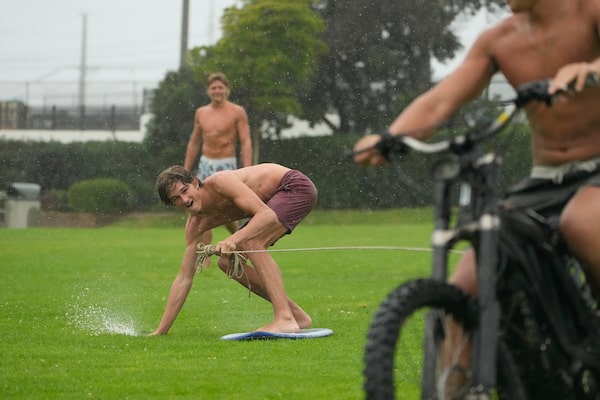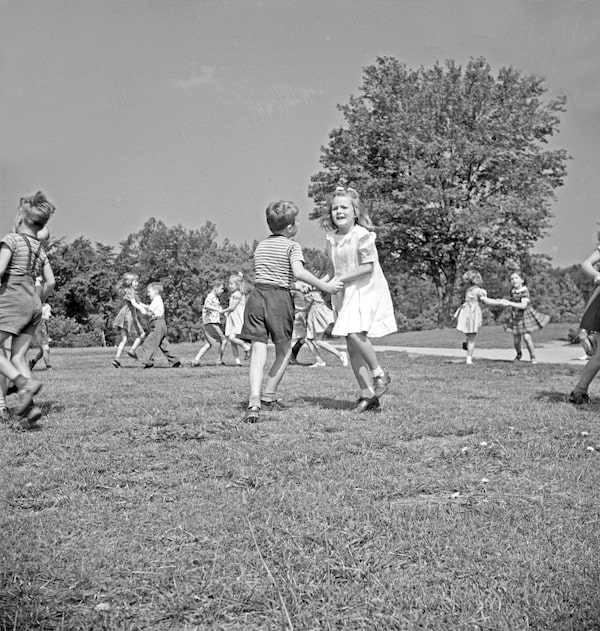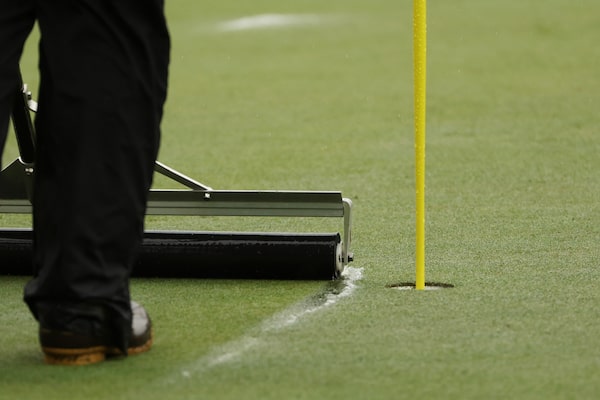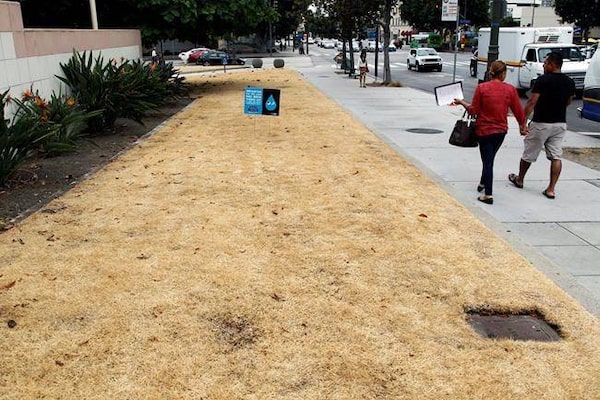Test plots of various grasses grow at an agricultural station in Riverside, Calif., where researchers are learning which plants are more drought- and heat-resistant than others.Nathan VanderKlippe/The Globe and Mail
On a plot of dusty land checked by patches of green a short drive east of Los Angeles, scientists are torture-testing grass. They drive back and forth until tracks bisect the blades. They leave patches of sod exposed to the blaring sun.
Their mission is to save the home lawn in a world parched by climate change.
Once, they turned off the irrigation for 60 summer days, leaving dozens of different grass genotypes alone to fend against scorching heat and desiccated soil. Many wilted. But one grass refused to fade to brown.
“I’m telling you, it was perfectly green,” says James Baird, who leads the turfgrass science program at the University of California, Riverside.
“It was like – that green.” He points to the plot he is standing on at the university’s Agricultural Experiment Station, a grass called Presidio, which is so state-of-the-art that it won’t reach market until next year, alongside a related cultivar, Coachella. Both are bermudagrasses, a warm-weather species developed as an alternative to the tall fescue that dominates lawns and golf courses in southern California.
Presidio and Coachella thrive on half the water used for tall fescue. They remain green with a quarter the water.
But that one survivor of the 60-day drought, which has no name and remains years of testing from any chance at commercial distribution, shows just how much is possible as scientists and geneticists and plant breeders across the continent work in service of the grasses that could preserve that most hallowed ornamentation of American properties.

Surfers in Carlsbad, Calif., use a rope and electric bike to ride on a lawn soaked by Tropical Storm Hilary this past August.Damian Dovarganes/The Associated Press
Lawns have become an unlikely villain in a world grappling with shifts in climate. Thirsty and nutritionally useless, they have become symbols of decadent overuse in dry southwestern states whose water supplies are rapidly vanishing. The California Water Service will pay homeowners to tear out grass. Cities in Arizona offer incentives for replacing lawns with xeriscaped gardens whose plants use little water.
Breeding a better grass might even sound like developing a low-nicotine cigarette.
“Grass doesn’t do anything other than just use water,” says Tick Segerblom, a director of the Las Vegas Valley Water District.
The apostles of turf, however, have reason to argue for the loveliness of the lawn. When temperatures rise, grass pumps water through its leaves, “making their own air conditioning, so to speak,” said Paul Raymer, a professor and turfgrass breeder at the University of Georgia. That keeps the grass alive. But “we benefit from that air conditioning, too,” he said.
Lawns are cooler than concrete, lessening urban heat island effects. (Although, critics point out, they provide far less cooling than trees.) They allow rains, when they come, to settle into the earth rather than coursing away. They sequester carbon. They provide a safe outdoor surface for children, pets and athletes. And they bring verdure, what Prof. Raymer calls a sense of “tranquillity.”
“It just makes us feel good to be surrounded by green,” he said.

Kindergartners practice May Day dances on their school's lawn in Greenbelt, Md., in 1942. The postwar boom would redefine Americans' relationship to green spaces and grass.Library of Congress/Library of Congress
The American front lawn began to take shape after the Civil War, but didn’t become an indispensable part of the country’s civic life until after the Second World War, when it became a pillar of suburban prosperity alongside the car and the interstate freeway.
The vast tracts of grass planted since that time now form a “savannah from coast to coast,” author Virginia Scott Jenkins writes in The Lawn: A History of an American Obsession. The lawn became so closely associated with a certain lifestyle that students in China’s Mao Zedong-led Cultural Revolution were ordered to tear them out as unwanted tokens of the bourgeoisie.
Not so in the U.S., where turfgrass today covers an area the size of Colorado, making it the third-most planted crop (behind corn and soybeans) and providing green grist for US$60-billion in annual economic activity. U.S. lawnmowers use 4.5 billion litres of gasoline a year, roughly equivalent to annual gas consumption in British Columbia.
The lawn industry can provide an obstacle to change. There is money to be made in irrigation systems. Green lawns are so desirable that some homeowner associations require them. Thirsty tall fescue remains popular in southern California because it can be kept green year-round, provided it receives enough water. (Fescue, ryegrasses and Kentucky bluegrass tend to dominate Canadian lawns.)

A greenskeeper clears water from the seventh green at the Augusta National Golf Club in Georgia.Patrick Smith/Getty Images
But change is coming, including from an industry for which turf is an existential concern. The U.S. Golf Association has committed to invest US$30-million over the next 15 years to help cut water used by golf courses. Irrigating more precisely – in part by using sensors to determine exactly how much is needed – is part of that. So is drought-resilient grass.
Matteo Serena, senior manager for irrigation research and services at the USGA, likens installing new turf to upgrading from a gas-powered car to an electrified vehicle. The economics can be tough. Equipping an entire golf course with new sod can cost millions of dollars. “It could take several decades to have a return on investment just from water costs for that,” he said.
Making change may also require adjustments to expectations. Some courses may need to irrigate only tees and greens, letting other areas go brown.
“You might have to offer a discount. But if there’s no water, that’s what it comes down to,” Mr. Serena said.
Homeowners, too, will likely need to embrace some brown on their lawns, at least during the driest months. Last year, Los Angeles temporarily banned all outdoor watering. In British Columbia’s Lower Mainland, summertime restrictions on watering lawns are growing more common.

In 2015, a dried-out lawn at Los Angeles City Hall bears a sign explaining that irrigation was shut off due to drought.Nick Ut/The Canadian Press
Prof. Raymer, meanwhile, says there are limits to what turf breeding can achieve. He isn’t optimistic about the future of the green yard in desert areas, which can’t “sustain a lawn without using excessive amounts of irrigation.” But in other areas, like the U.S. south-east, the goal is to breed grasses that don’t need to be watered once established. Other efforts are increasing the salt-tolerance of grasses, which can allow them to thrive on treated effluent water.
Scientists are both competing and collaborating. Prof. Baird, for example, maintains a patch of Tiftuf, developed at the University of Georgia, at his test plot in California.
And Marta Pudzianowska, a turfgrass breeder who works alongside Prof. Baird, gets a thrill when she looks at what is being bred for the future.
“We can look at each other’s grasses, and we know: okay, so we have great grasses now. But we can see some new experimental lines coming from the other programs, and we know that’s going to be the new benchmark.” The progress is visible.
“It’s actually beautiful,” she says.
Researcher James Baird and turfgrass breeder Marta Pudzianowska hope to find new plants that are better adapted to a changing climate.Nathan VanderKlippe/The Globe and Mail
 Nathan VanderKlippe
Nathan VanderKlippe